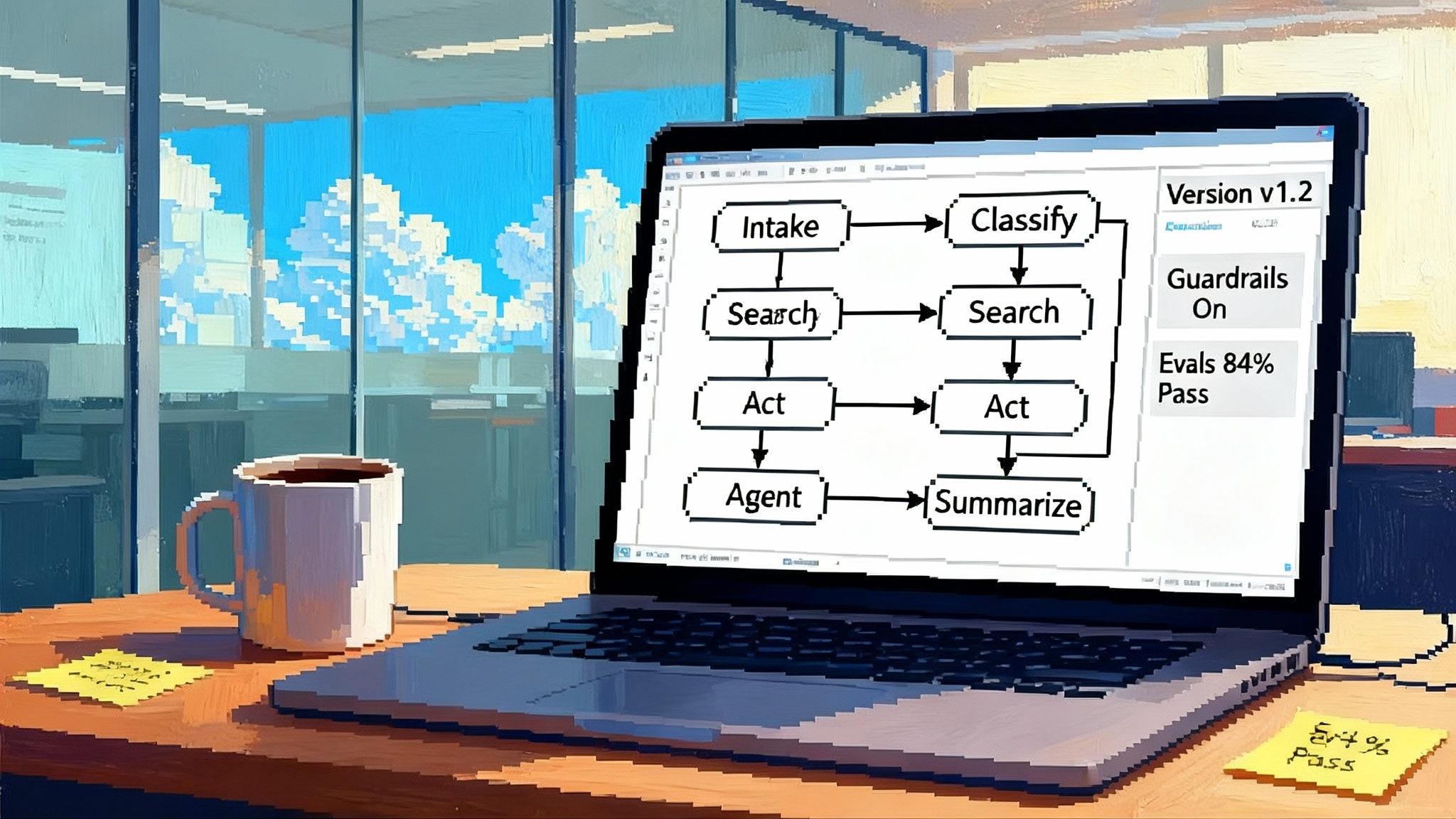GitHub Agent HQ turns your repo into mission control
Unveiled at GitHub Universe on October 28, 2025, Agent HQ brings third party coding agents from OpenAI, Anthropic, Google, xAI, Cognition, and more into a neutral control plane inside the repository. Here is how it turns fragmented agent work into a single cockpit with clear plans, policy, and proof.

The breakthrough: the repo becomes the cockpit
On October 28, 2025, at Universe, GitHub unveiled Agent HQ, a native way to orchestrate multiple coding agents inside the developer flow you already use. Mission control shows up everywhere you work: in the repository, inside pull requests and issues, in Visual Studio Code, on mobile, and in the command line. GitHub’s pitch is simple and bold: bring third party agents from OpenAI, Anthropic, Google, Cognition, xAI, and others into one neutral control plane, then let teams direct them from the source of truth, the repository itself. That makes the repo the cockpit and agents the flight crew. The announcement lands with specifics, from branch controls to identity and audit, not just a vision piece. You can read details in Introducing Agent HQ on the GitHub Blog.
This matters because agent development has fragmented across tools. Some agents live in editors. Others run as bots in chat. A few act like continuous integration robots. That patchwork creates cognitive switching costs, inconsistent governance, and duplicated logs. Agent HQ reframes the problem: make the repo the operating theater where planning, implementation, review, and release happen in sequence and in the open. We have tracked the same push toward durable orchestration as Google put AgentOps on stage and as OpenAI AgentKit made agents production-ready.
Why a neutral, repo-centric layer unlocks real multi-agent work
Multi-agent coding sounds futuristic until you map it to a workflow teams already recognize:
- Plan: turn a high level goal into a testable plan.
- Implement: assign work to specialized agents in parallel.
- Review: gate changes through automated and human checks.
- Ship: merge, deploy, and verify.
When this loop happens in disconnected tools, you get drift. Plans live in a document. Edits happen in a local editor. Automated checks run in a pipeline few people read. Decisions are scattered across chat threads. A neutral orchestration layer inside the repo fixes the alignment problem. It collects context at the source, keeps changes visible in pull requests, tracks who or what made a decision, and funnels every action through the policies that already govern the codebase.
Concretely, mission control lets you choose a mix of agents and assign them to a single issue or pull request while keeping a shared log. The planner agent decomposes tasks; an implementation agent writes code; a test agent runs suites and interprets failures; a security agent suggests remediations. Because they operate on repository primitives, they can coordinate without brittle glue. The plan becomes a living checklist in the pull request. Commit messages refer back to that plan. Reviews tag the right owners. If something fails, the failure is local to a branch with clear provenance.
The neutral part matters. Agent HQ is not a single model or a single vendor feature. It is an integration surface. Picking the best agent for each job becomes as routine as selecting a test runner. Teams can swap agents over time without changing the underlying workflow. That decoupling is what turns multi-agent work from a demo into a durable practice.
The governance primitives that make this enterprise ready
Enterprises adopt tools when the controls fit how they already manage risk. GitHub wired Agent HQ into the primitives that security and platform teams already understand:
- Identity: each agent operates as a first class identity with scoped permissions. You can tell which agent authored a commit, opened a pull request, or triggered a workflow. That makes accountability reviewable instead of inferred.
- Policy: least privilege is the starting point. Teams can limit which repositories or branches an agent can touch, restrict access to production secrets, and define when an agent may request human approval.
- Audit: all agent actions flow into the same audit trail as human actions. That simplifies compliance reviews, incident response, and root cause analysis because there is one log of record.
- Branch controls: org level and repo level rules gate where agents can push, when checks must pass, and whether merges require human sign off. You can allow agents to open pull requests but block them from merging to main without a code owner review.
These controls should feel familiar because they extend GitHub’s existing fabric. The key difference is that agents are not sidecar scripts. They are governed actors. For a broader security backdrop on agent adoption, see our analysis on the agent security stack going mainstream.
Patterns you can put in place this quarter
Agent HQ arrives with new behaviors in Visual Studio Code and a handful of simple patterns that make teams effective right away.
1) Plan Mode as the default entry point
In Visual Studio Code, Plan Mode helps agents outline the steps they intend to take before writing code. Treat this like a preflight checklist. For any non trivial change, require a plan to be visible in the pull request description. Make it concrete: expected files to touch, tests to add, acceptance criteria, rollback plan. That plan becomes the substrate for parallelization. A reviewer can approve certain steps and hold others for human work.
How to roll it out: add a pull request template with a Plan section. Teach agents to populate it. Require a status check that the plan exists and references at least one test.
2) Adopt AGENTS.md to give machines the context humans take for granted
Agents work better when you tell them how your repo really works. AGENTS.md is an emerging convention that acts like a README for agents. It specifies build steps, test conventions, linters, deployment rhythms, and any tribal knowledge that normally lives in a senior engineer’s head. The format is simple Markdown and vendor neutral. A good starting point is the open source template in the openai/agents.md repository.
How to roll it out: create AGENTS.md at the repo root. Include the exact commands to build and test locally, where to find fixtures, how to run security scans, naming conventions for branches, and instructions for monorepos. For large monorepos, place nested AGENTS.md files in each package so agents read the nearest one.
3) Treat agents like teammates in branch protections
Model agent access the same way you would a new hire. Start with a sandbox branch, require reviews from code owners, and enable required status checks for test and security gates. Consider separate branches for agent proposals, for example agent/<task-id>, and apply different rules to those branches. If you use signed commits, give each agent a unique signing key and enforce signature verification.
4) Introduce an agent review rotation
Agents can review code too, especially for repetitive checks. Configure a code review agent to run CodeQL and coverage checks, then leave structured comments that point to policy sections in AGENTS.md. Pair this with a human reviewer rotation so learning goes both ways. Humans handle architecture and product tradeoffs. Agents handle consistency and completeness.
5) Instrument the work
Decisions improve when teams see the impact. Track the deltas between agent and human work: time to first review, cycles to green, test failures found before merge, incidents after release. Keep a simple weekly dashboard that shows the fraction of pull requests opened by agents and the average number of plan steps executed before a human review.
How Agent HQ could reset the IDE wars
For years, the editor was the center of gravity. Vendors fought to keep you inside their pane of glass. Agent HQ shifts the center back to the repository. The repo is where context lives and where governance is applied. Editors become windows into the same mission control. That weakens the winner-takes-all dynamics of the editor market and rewards vendors who integrate deeply with repo workflows.
This does not mean Visual Studio Code stops mattering. GitHub is shipping handy surfaces like Plan Mode and agent customization inside the editor. It does mean that a team using Visual Studio Code and a team using JetBrains or Cursor can still run the same agent plan and land it with the same policies, because the plan, the execution, and the review all resolve to pull requests and issues instead of proprietary sidebars. The repo becomes the battlefield and the peace treaty.
Expect a year of quick moves. Editor vendors will race to support Agent HQ signals, like rendering plan steps inline, showing agent identity on diffs, and letting developers steer multiple agents without context switching. But the differentiator will be how well an editor expresses repository policy and agent state, not how many prompts it stores.
CI/CD will look more like a flight plan than a conveyor belt
Continuous integration and continuous delivery pipelines used to be linear: build, test, deploy. Agent HQ nudges teams toward a branching flight plan where checkpoints trigger specific agents. A plan step that touches authentication code might automatically add a security review gate. A failing integration test can summon a test focused agent to diagnose flaky fixtures. A change that bumps a package with a known vulnerability can block merge and open a remedial task with a dependency agent.
Over time, the distinction between pipelines and plans will fade. Plans will generate pipelines. Pipelines will annotate plans with evidence. The output will be a pull request with a visible narrative: here is what we intended, here is what we changed, here are the checks that passed, here is who approved it, here is what happened in production. That narrative is gold for auditors, incident responders, and new teammates.
The marketplace moment: from one Copilot to many specialists
If Actions turned workflows into a marketplace of composable steps, Agent HQ sets the stage for a marketplace of composable behaviors. Think specialized agents for particular stacks or tasks:
- A database migration agent that understands Liquibase and Flyway edge cases.
- A design system agent that updates tokens, regenerates snapshots, and runs visual diffs.
- A mobile release agent that manages phased rollouts on iOS and Android with crash budget policies.
- A compliance agent that checks for policy violations and prepares change records for auditors.
A credible marketplace will require three ingredients: capability claims that are testable, verification signals tied to real repos and real plans, and policy bindings that limit what an agent can do without approval. The vendor that nails those ingredients will earn trust beyond the demo stage.
Predictions for the next six months
- The repo becomes the de facto source of behavioral policy for agents. Teams that centralize instructions in AGENTS.md and branch rules will see faster cycle time with fewer regressions than teams that rely on chat prompts.
- Parallelism will be the headline win. The most effective teams will run two to four agents per plan in parallel and cut time to first review by 30 to 50 percent on medium changes.
- Editor differentiation shifts from prompt quality to policy fidelity. Editors that clearly visualize plan steps, agent identities, and policy gates inside the same view gain share.
- Security leaders will adopt a simple rule: no agent merges to main without human sign off and passing security checks. Exceptions will be limited to low risk domains with automated rollbacks.
- A nascent agent marketplace emerges inside GitHub with early leaders focused on testing, migrations, and documentation. The first compliance verified agents arrive with signed attestations and published incident policies.
Metrics that matter
Executives will ask for impact. Here are metrics worth tracking and why:
- Plan completeness rate: percent of pull requests with a plan that lists tests and acceptance criteria. Healthy teams exceed 85 percent.
- Parallelization factor: average number of agents working on a plan concurrently. Watch this move from 1.2 to 2.5.
- Time to first review: median minutes from plan creation to first human review. Tie improvements to developer satisfaction surveys.
- Rework ratio: commits after review that change more than 20 percent of the diff. Down is good. Rework above 0.4 suggests plans are unclear or tests are insufficient.
- Post merge incident rate: issues opened within seven days of release that are linked to agent authored pull requests. Segment by agent and task type.
- Cost per merged change: cloud and licensing spend divided by merged pull requests. Track the agent component to ensure you are buying cycle time, not noise.
- Security findings pre merge: number of CodeQL or policy violations caught before main. Aim to move detection earlier in the plan.
What to do on Monday
- Stand up a pilot repo with Agent HQ turned on. Start with non critical services.
- Create AGENTS.md and make it the single source for machine readable conventions. Keep the README focused on humans.
- Add a pull request template with a Plan section. Require it for agent authored pull requests.
- Configure branch protections so agents can open pull requests but cannot merge without a human review and passing checks.
- Establish clear scope for each approved agent: stacks, directories, and task types. Deny access to secrets by default.
- Set up a weekly review where your platform team looks at the metrics above and tunes policies.
The bigger picture
Agent HQ is not about replacing developers. It is about moving the center of gravity back to where software decisions live. When the repo becomes mission control, the plan is visible, the implementation is auditable, the review is enforceable, and the release is reversible. Vendors compete on who plays best with your rules, not on who locks you into theirs.
That is how multi agent development stops being a demo and starts compounding. The neutral control plane gives you freedom to pick the right specialist for each job without tearing up your workflow every quarter. If the last decade was about getting everyone to collaborate in one place, the next one is about getting every intelligent tool to collaborate under the same roof and the same rules. The repo, once just where code lived, now runs the tower. Wheels up.








